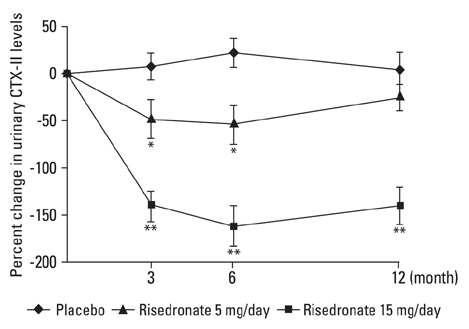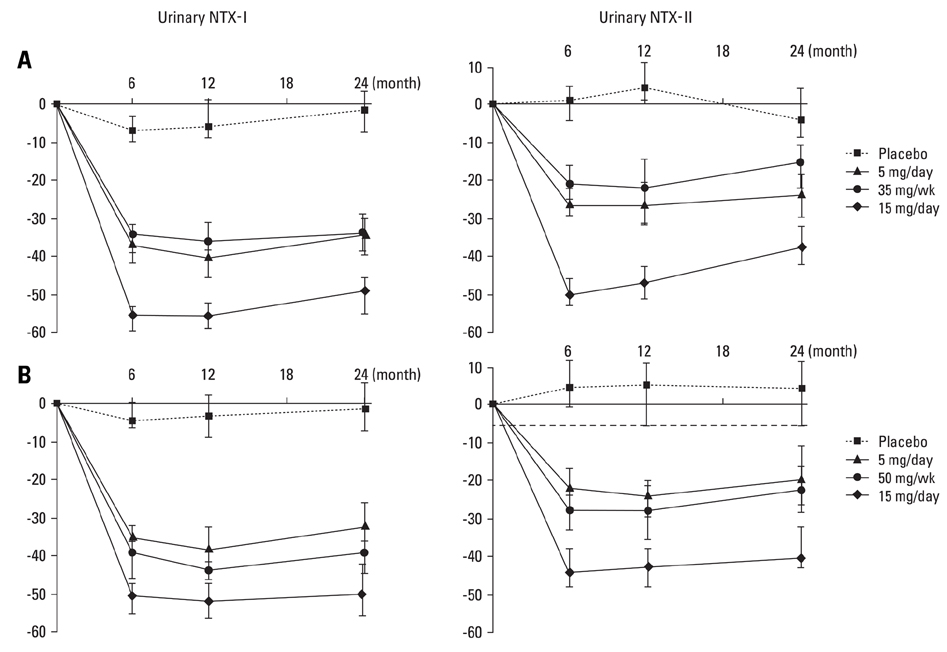Yonsei Med J.
2010 Mar;51(2):164-170. 10.3349/ymj.2010.51.2.164.
Effects of Risedronate on Osteoarthritis of the Knee
- Affiliations
-
- 1Institute for Integrated Sports Medicine, Keio University School of Medicine, Tokyo, Japan. jiwamoto@sc.itc.keio.ac.jp
- 2Department of Neurology, Mitate Hospital, Fukuoka, Japan.
- KMID: 1126013
- DOI: http://doi.org/10.3349/ymj.2010.51.2.164
Abstract
- The purpose of the present study was to discuss the effects of risedronate on osteoarthritis (OA) of the knee by reviewing the existing literature. The literature was searched with PubMed, with respect to prospective, double-blind, randomized placebo-controlled trials (RCTs), using the following search terms: risedronate, knee, and osteoarthritis. Two RCTs met the criteria. A RCT (n = 231) showed that risedronate treatment (15 mg/day) for 1 year improved symptoms. A larger RCT (n = 1,896) showed that risedronate treatment (5 mg/day, 15 mg/day, 35 mg/week, and 50 mg/week) for 2 years did not improve signs or symptoms, nor did it alter radiological progression. However, a subanalysis study (n = 477) revealed that patients with marked cartilage loss preserved the structural integrity of subchondral bone by risedronate treatment (15 mg/day and 50 mg/week). Another subanalysis study (n = 1,885) revealed that C-terminal crosslinking telopeptide of type II collagen (CTX-II) decreased with risedronate treatment in a dose-dependent manner, and levels reached after 6 months were associated with radiological progression at 2 years. The results of these RCTs show that risedronate reduces the marker of cartilage degradation (CTX-II), which could contribute to attenuation of radiological progression of OA by preserving the structural integrity of subchondral bone. The review of the literature suggests that higher doses of risedronate (15 mg/day) strongly reduces the marker of cartilage degradation (CTX-II), which could contribute to attenuation of radiological progression of OA by preserving the structural integrity of subchondral bone.
Keyword
MeSH Terms
Figure
Reference
-
1. Sowers M. Epidemiology of risk factors for osteoarthritis: systemic factors. Curr Opin Rheumatol. 2001. 13:447–451.2. Kawaguchi H. Regulation of osteoarthritis development by Wnt-beta-catenin signaling through the endochondral ossification process. J Bone Miner Res. 2009. 24:8–11.
Article3. Zhang W, Moskowitz RW, Nuki G, Abramson S, Altman RD, Arden N, et al. OARSI recommendations for the management of hip and knee osteoarthritis, Part II: OARSI evidence-based, expert consensus guidelines. Osteoarthritis Cartilage. 2008. 16:137–162.4. Spector TD. Bisphosphonates: potential therapeutic agents for disease modification in osteoarthritis. Aging Clin Exp Res. 2003. 15:413–418.
Article5. Hayami T, Pickarski M, Wesolowski GA, McLane J, Bone A, Destefano J, et al. The role of subchondral bone remodeling in osteoarthritis: reduction of cartilage degeneration and prevention of osteophyte formation by alendronate in the rat anterior cruciate ligament transection model. Arthritis Rheum. 2004. 50:1193–1206.
Article6. Muehleman C, Green J, Williams JM, Kuettner KE, Thonar EJ, Sumner DR. The effect of bone remodeling inhibition by zoledronic acid in an animal model of cartilage matrix damage. Osteoarthritis Cartilage. 2002. 10:226–233.
Article7. Bendele AM, Hulman JF. Spontaneous cartilage degeneration in guinea pigs. Arthritis Rheum. 1988. 31:561–565.8. Spector TD, Conaghan PG, Buckland-Wright JC, Garnero P, Cline GA, Beary JF, et al. Effect of risedronate on joint structure and symptoms of knee osteoarthritis: results of the BRISK randomized, controlled trial [ISRCTN01928173]. Arthritis Res Ther. 2005. 7:R625–R633.9. Bingham CO 3rd, Buckland-Wright JC, Garnero P, Cohen SB, Dougados M, Adami S, et al. Risedronate decreases biochemical markers of cartilage degradation but does not decrease symptoms or slow radiographic progression in patients with medial compartment osteoarthritis of the knee: results of the two-year multinational knee osteoarthritis structural arthritis study. Arthritis Rheum. 2006. 54:3494–3507.
Article10. Buckland-Wright JC, Messent EA, Bingham CO 3rd, Ward RJ, Tonkin C. A 2 yr longitudinal radiographic study examining the effect of a bisphosphonate (risedronate) upon subchondral bone loss in osteoarthritic knee patients. Rheumatology (Oxford). 2007. 46:257–264.11. Garnero P, Aronstein WS, Cohen SB, Conaghan PG, Cline GA, Christiansen C, et al. Relationships between biochemical markers of bone and cartilage degradation with radiological progression in patients with knee osteoarthritis receiving risedronate: the Knee Osteoarthritis Structural Arthritis randomized clinical trial. Osteoarthritis Cartilage. 2008. 16:660–666.
Article12. Bruyère O, Burlet N, Delmas PD, Rizzoli R, Cooper C, Reginster JY. Evaluation of symptomatic slow-acting drugs in osteoarthritis using the GRADE system. BMC Musculoskelet Disord. 2008. 9:165.13. Altman R, Asch E, Bloch D, Bole G, Borenstein D, Brandt K, et al. Development of criteria for the classification and reporting of osteoarthritis. Classification of osteoarthritis of the knee. Diagnostic and Therapeutic Criteria Committee of the American Rheumatism Association. Arthritis Rheum. 1986. 29:1039–1049.14. Bellamy N, Buchanan WW, Goldsmith CH, Campbell J, Stitt LW. Validation study of WOMAC: a health status instrument for measuring clinically important patient relevant outcomes to antirheumatic drug therapy in patients with osteoarthritis of the hip or knee. J Rheumatol. 1988. 15:1833–1840.15. Centre for Evidence-Based Medicine. Oxford-Centre Evidence Based Medicine. Levels of Evidence and Grades of Recommendation. http://www.cebm.net/levels_of_evidence.asp.16. Bettica P, Cline G, Hart DJ, Meyer J, Spector TD. Evidence for increased bone resorption in patients with progressive knee osteoarthritis: longitudinal results from the Chingford study. Arthritis Rheum. 2002. 46:3178–3184.17. Li B, Aspden RM. Mechanical and material properties of the subchondral bone plate from the femoral head of patients with osteoarthritis or osteoporosis. Ann Rheum Dis. 1997. 56:247–254.18. Buckland-Wright JC, Macfarlane DG, Jasani MK, Lynch JA. Quantitative microfocal radiographic assessment of osteoarthritis of the knee from weight bearing tunnel and semiflexed standing views. J Rheumatol. 1994. 21:1734–1741.19. Wluka AE, Wang Y, Davis SR, Cicuttini FM. Tibial plateau size is related to grade of joint space narrowing and osteophytes in healthy women and in women with osteoarthritis. Ann Rheum Dis. 2005. 64:1033–1037.20. Jones G, Ding C, Scott F, Glisson M, Cicuttini F. Early radiographic osteoarthritis is associated with substantial changes in cartilage volume and tibial bone surface area in both males and females. Osteoarthritis Cartilage. 2004. 12:169–174.
Article21. Tissakht M, Ahmed AM, Chan KC. Calculated stress-shielding in the distal femur after total knee replacement corresponds to the reported location of bone loss. J Orthop Res. 1996. 14:778–785.22. Bettica P, Cline G, Hart DJ, Meyer J, Spector TD. Evidence for increased bone resorption in patients with progressive knee osteoarthritis: longitudinal results from the Chingford study. Arthritis Rheum. 2002. 46:3178–3184.23. Dufresne TE, Chmielewski PA, Manhart MD, Johnson TD, Borah B. Risedronate preserves bone architecture in early postmenopausal women in 1 year as measured by three-dimensional microcomputed tomography. Calcif Tissue Int. 2003. 73:423–432.24. Oestergaard S, Sondergaard BC, Hoegh-Andersen P, Henriksen K, Qvist P, Christiansen C, et al. Effects of ovariectomy and estrogen therapy on type II collagen degradation and structural integrity of articular cartilage in rats: implications of the time of initiation. Arthritis Rheum. 2006. 54:2441–2451.
Article25. Bay-Jensen AC, Andersen TL, Charni-Ben Tabassi N, Kristensen PW, Kjaersgaard-Andersen P, Sandell L, et al. Biochemical markers of type II collagen breakdown and synthesis are positioned at specific sites in human osteoarthritic knee cartilage. Osteoarthritis Cartilage. 2008. 16:615–623.
Article26. Saag KG. Bisphosphonates for osteoarthritis prevention: "Holy Grail" or not? Ann Rheum Dis. 2008. 67:1358–1359.
Article27. Neogi T, Nevitt MC, Ensrud KE, Bauer D, Felson DT. The effect of alendronate on progression of spinal osteophytes and discspace narrowing. Ann Rheum Dis. 2008. 67:1427–1430.
Article28. Bruyere O, Delferriere D, Roux C, Wark JD, Spector T, Devogelaer JP, et al. Effects of strontium ranelate on spinal osteoarthritis progression. Ann Rheum Dis. 2008. 67:335–339.
Article
- Full Text Links
- Actions
-
Cited
- CITED
-
- Close
- Share
- Similar articles
-
- Effects of Risedronate on Osteoarthritis of the Knee
- Protective effect of glucosamine and risedronate (alone or in combination) against osteoarthritic changes in rat experimental model of immobilized knee
- High Tibial Osteotomy for Medial Knee Osteoarthritis
- Arthroscopic debridement in osteoarthritis of the knee
- Total knee arthroplasty in osteoarthritis



